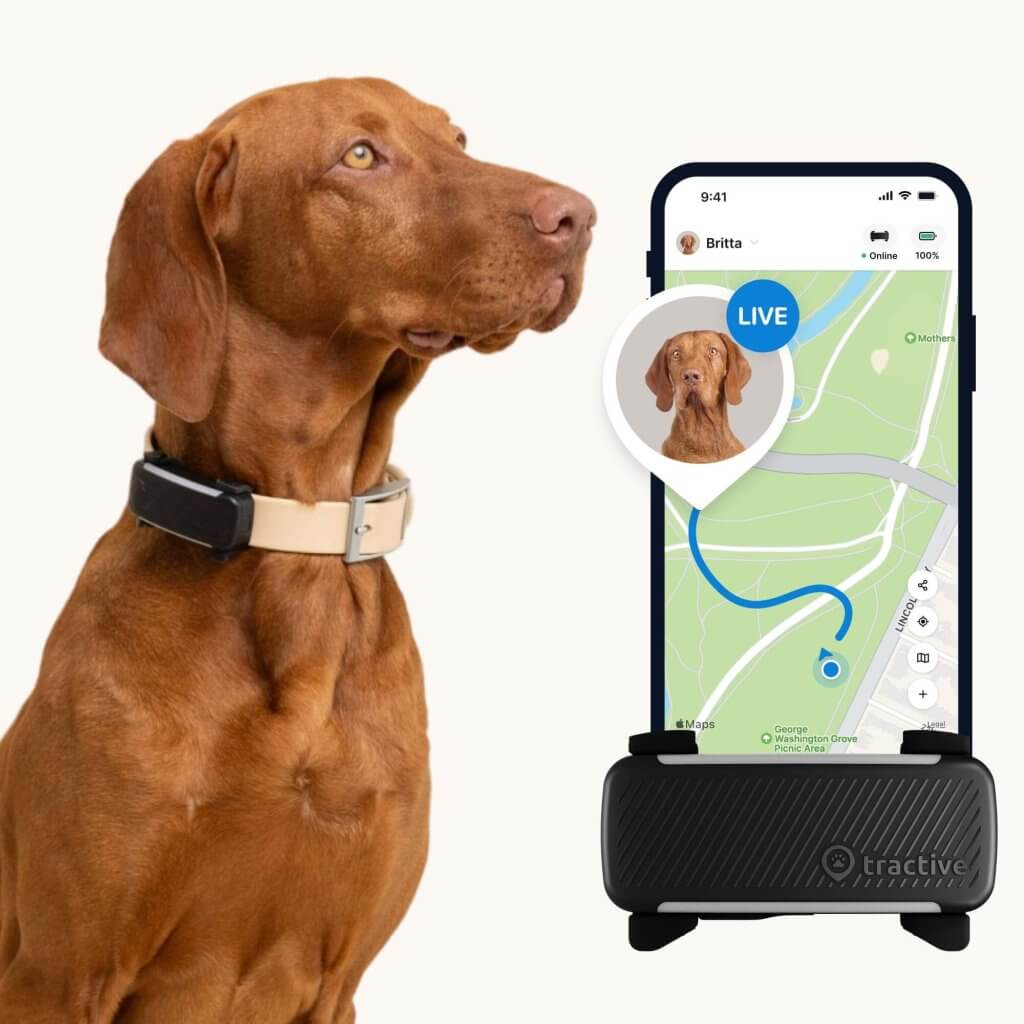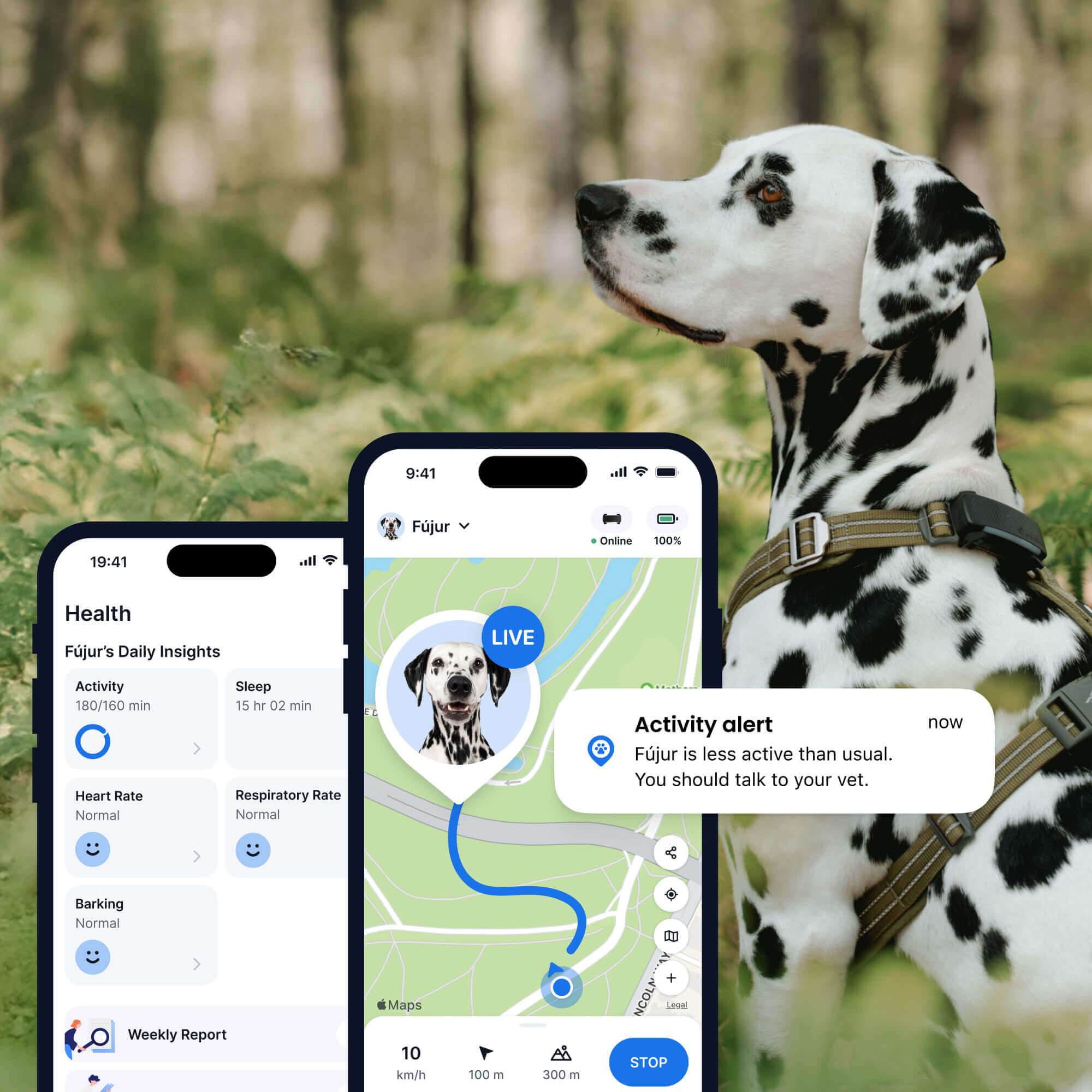How Hot is Too Hot for Dogs? Tips For A Safe Summer
Keeping your dog safe in the heat needs a little planning. Here's how hot is too hot for dogs when you're out on a walk, running, or even indoors.

You might love soaking up the sun, but the rising temperatures can pose a serious risk to our furry friends. Dogs don’t regulate heat the same way we do. So they’re at higher risk of overheating and developing potentially fatal conditions, like heat stroke. So, how hot is too hot for dogs? And how can you keep them safe while not skipping out on walks and playtime? Here are some safety tips – plus where a smart dog tracker with Health Monitoring can step in as an emergency measure.
Key Takeaways
In general, try and avoid stepping outdoors when it’s above 28∘C / 82∘F. This counts as high-risk temperatures for most dogs and is likely to make them overheat.
Aim to keep your indoor temperature between 22∘C – 26∘C (72∘F – 79∘F) – but do plan ahead if you aren’t going to be around when your dog’s at home alone.
A smart dog tracker with Health Monitoring (like Tractive) can help you pick up on the signs of heat stroke in dogs quicker, like an elevated heart rate or excessive panting.

Always know your buddy is healthy & safe
Read moreHow hot is too hot for dogs – when you’re out on a walk?
There’s no single magic number, as it depends on your dog’s breed, coat, age, and health. Remember, humidity also plays a huge role and can make it harder for dogs to cool down. Here are some general figures to help you plan your outdoor activities accordingly:
| Temperature Range (C/F) | Recommendations |
|---|---|
| Below 20∘C / 68∘F | Generally safe for most dogs, but always monitor for signs of discomfort. |
| 20∘C – 24∘C / 68∘F – 75∘F | Moderate risk: Shorten walks, stick to shade, and offer plenty of water. Pay close attention to flat-faced breeds or those with thick coats. |
| 24∘C – 28∘C / 75∘F – 82∘F | High risk: Only quick toilet breaks. Avoid strenuous activity. The pavement will also most likely be too hot. |
| Above 28∘C / 82∘F | Dangerous: Avoid walking altogether, except for very brief toilet breaks outside. |
💡 A smart dog tracker with Health Monitoring can help you catch on early to the potential signs of heat stroke in dogs – like an elevated heart rate or excessive panting. Plus, with real-time GPS tracking, you’ll never have to fear losing your dog while out on a walk or if they escape from home when it’s hot outdoors.

Follow your dog anywhere
Get real-time location information, wherever they go. And find out when they try to make an escape, or just when they go somewhere they shouldn’t, with Virtual Fences.
Can I run with dogs in hot weather?
Generally yes, but high temperatures mean extra precautions. Before you leash up:
- Consider their breed, age, and health
Older dogs, puppies, and dogs with underlying health conditions (like Brachycephalic dog breeds) are at higher risk for overheating. Always consult your vet before starting a running routine, especially if your dog falls into any of these categories. - Hydrate, hydrate, hydrate
Bring at least twice as much water as you think you’ll need. Offer water every 10-15 minutes, even if your dog doesn’t seem thirsty. A portable, collapsible water bowl can help. - Only go for a run at dawn or dusk
I.e., the coolest parts of the day. Pay attention to the “feels like” temperature, which accounts for humidity. On very hot or humid days, it might be safer to skip the run altogether and stick to some indoor games for dogs instead. - Shorten your route and intensity
Even if your dog usually handles longer distances, their body will be working much harder to cool down. A quick, easy jog around a shaded park is much safer than an intense sprint on open pavement. - Avoid asphalt and hot surfaces
If you can’t comfortably hold the back of your hand on the surface for seven seconds, it’s too hot for your dog’s paws. Stick to grass, dirt trails, or shaded paths. - Don’t skip the post-run cool-down
After your run, walk slowly for a few minutes, offer water, and consider wiping down their paws, belly, and armpits with cool, damp cloths. Never use ice water directly on their skin, as it can cause blood vessels to constrict and actually hinder cooling.
Read More: Running With Dogs? Tips To Keep It Safe & Sporty
Is my dog overheating? Signs to watch out for
If you notice any of these signs, stop immediately, move to a shaded area, offer water, and try to cool them down. If signs persist or worsen, head to your vet right away:
- Excessive panting or drooling
- Dark red or bright red gums
- Lethargy or seeking shade
- Lagging behind or refusing to move
- Stumbling, wobbling, or collapsing
- Vomiting or diarrhea
- Dizziness or confusion
- Muscle tremors
Read More: Heat Stroke In Dogs: How To Spot It Early & What To Do
How hot is too hot for dogs – indoors?
Ideally, when you’re home, aim to keep your indoor temperature between 22∘C-26∘C (72∘F-79∘F). If you’re out of home, here are some tips on how to prevent it from getting too hot indoors:
- Keep your indoors well-circulated
Fans can help evaporate sweat from your dog’s paws and help them stay cool. Make sure to position them somewhere your dog can’t knock over. Open windows (with secure screens!) can also help, especially if there’s a good cross-breeze. Else, leave the air-conditioning on with a program to have it turn off once the indoors have reached a comfortable temperature. - Make sure your dog can always access water
Whether it’s from a fountain or even a water dispenser. You could also add ice cubes to their bowl to encourage drinking. - Try cooling aids
Cooling mats (gel-filled or water-activated) can provide a great spot for your dog to lie down and regulate their body temperature. Elevated dog beds also promote airflow underneath. Plus, they’re a cooler sleeping surface than the floor. - Keep it dark indoors
During the hottest parts of the day, keep blinds or curtains closed, particularly on south-facing windows. This can significantly reduce the heat gain inside your home. - Prepare for power outages
Have a plan for what to do if your air conditioning fails or if there’s a power outage during a heatwave. This might mean having a designated cooler space elsewhere or knowing when it’s safer to board your dog or take them to a friend’s house. - Never leave your dog in a confined space
Just like cars, poorly-ventilated rooms can become death traps. Make sure there’s consistent airflow and a cool environment, especially if you’re leaving your dog home alone.
How a smart dog tracker can help in an emergency
In hot weather, a smart dog tracker with Health Monitoring – like Tractive – can be an invaluable tool for your dog’s safety. Strapped to your dog’s collar, you can now:
- Track your dog in real-time
If your dog manages to slip away or get lost, especially in hot weather, every second counts. Real-time GPS tracking allows you to pinpoint their exact location instantly, so you can retrieve them before they overheat outdoors. Plus, unlike an Apple AirTag, Tractive GPS trackers don’t need a network of compatible devices to work. Nor are they limited by any range. - Catch on to the signs of heat stroke early
An elevated heart-rate or excessive panting could both be signs of heat stroke in dogs. With your tracker’s Vital Signs monitoring features, you can now pick on to a change in your dog’s breathing or heart rate much before they have a chance to worsen.
- Spot potential health issues early
Your tracker comes with a built-in motion detector that monitors your dog’s activity throughout the day. If there’s a weird drop in their activity – which may signal lethargy or discomfort – you’ll get a Health Alert to your phone, prompting you to take action. - Figure out if something’s stressing out your dog at home
Your tracker also includes Bark Monitoring and a Separation Anxiety monitor to alert you if your dog is showing signs of anxiety – like excessive barking or restless pacing. If it’s a hot day outdoors, this could signal their discomfort as well, so you can take action right away. (And, say, get someone to check up on them, if you can’t drop by home yourself.)
☀️ Keeping your dog safe in the heat needs a little extra planning and prep. But by understanding the risks and taking a few steps, you’ll be on your way to enjoying a safe, sporty summer with your buddy by your side.




